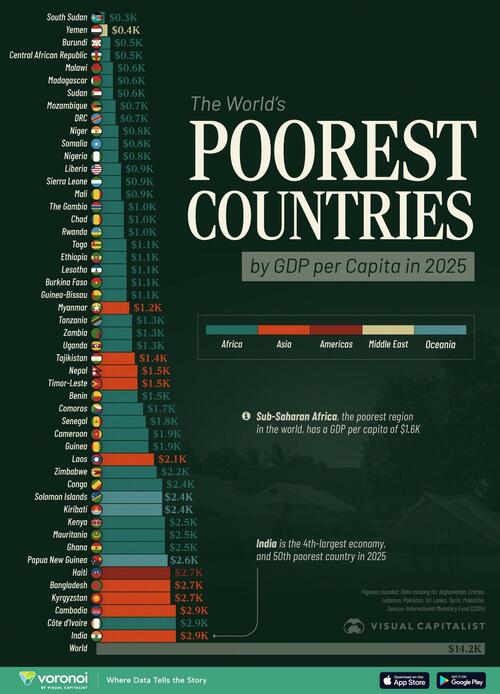
These Are The 50 Poorest Countries By GDP Per Capita In 2025
GDP per capita offers a quick litmus test of how wealth is generated per person within a country. By dividing total economic output by population, it levels the playing field between nations of very different sizes.
The infographic, via Visual Capitalist’s Pallavi Rao, highlights the 50 poorest countries in the world by this measure, based on 2025 estimates from the International Monetary Fund.

All values are in 2025 U.S. dollars. Data is missing for Afghanistan, Eritrea, Lebanon, Pakistan, Sri Lanka, Syria, Palestine.
GDP per capita doesn’t account for: local prices, currency exchange rates, or distribution variance within the country. There’s also a more existential question of whether economic output can be equated to wealth.
Measuring Relative Economic Productivity
South Sudan is the poorest country in the world in 2025, with a $251 GDP per capita.
More startlingly, India makes the list as well. It’s the 50th poorest by GDP per capita ($2,878), a rare case of a top-five economy by GDP having low levels of individual productivity.
| 1 | South Sudan | Africa | $251 |
| 2 | Yemen | Middle East | $417 |
| 3 | Burundi | Africa | $490 |
| 4 | Central African Republic |
Africa | $532 |
| 5 | Malawi | Africa | $580 |
| 6 | Madagascar | Africa | $595 |
| 7 | Sudan | Africa | $625 |
| 8 | Mozambique | Africa | $663 |
| 9 | DRC | Africa | $743 |
| 10 | Niger | Africa | $751 |
| 11 | Somalia | Africa | $766 |
| 12 | Nigeria | Africa | $807 |
| 13 | Liberia | Africa | $908 |
| 14 | Sierra Leone | Africa | $916 |
| 15 | Mali | Africa | $936 |
| 16 | Gambia | Africa | $988 |
| 17 | Chad | Africa | $991 |
| 18 | Rwanda | Africa | $1,043 |
| 19 | Togo | Africa | $1,053 |
| 20 | Ethiopia | Africa | $1,066 |
| 21 | Lesotho | Africa | $1,098 |
| 22 | Burkina Faso | Africa | $1,107 |
| 23 | Guinea-Bissau | Africa | $1,126 |
| 24 | Myanmar | Asia | $1,177 |
| 25 | Tanzania | Africa | $1,280 |
| 26 | Zambia | Africa | $1,332 |
| 27 | Uganda | Africa | $1,338 |
| 28 | Tajikistan | Asia | $1,432 |
| 29 | Nepal | Asia | $1,458 |
| 30 | Timor-Leste | Asia | $1,491 |
| 31 | Benin | Africa | $1,532 |
| 32 | Comoros | Africa | $1,702 |
| 33 | Senegal | Africa | $1,811 |
| 34 | Cameroon | Africa | $1,865 |
| 35 | Guinea | Africa | $1,904 |
| 36 | Laos | Asia | $2,096 |
| 37 | Zimbabwe | Africa | $2,199 |
| 38 | Congo | Africa | $2,356 |
| 39 | Solomon Islands |
Oceania | $2,379 |
| 40 | Kiribati | Oceania | $2,414 |
| 41 | Kenya | Africa | $2,468 |
| 42 | Mauritania | Africa | $2,478 |
| 43 | Ghana | Africa | $2,519 |
| 44 | Papua New Guinea |
Oceania | $2,565 |
| 45 | Haiti | Americas | $2,672 |
| 46 | Bangladesh | Asia | $2,689 |
| 47 | Kyrgyz Republic | Asia | $2,747 |
| 48 | Cambodia | Asia | $2,870 |
| 49 | Côte d’Ivoire | Africa | $2,872 |
| 50 | India | Asia | $2,878 |
Nigeria (8th poorest, $807) is another less dramatic example of large economy whose population brings down its GDP per capita.
However, the gap between the poorest and even moderately poor countries is vast. South Sudan at $251 per capita has roughly one-eleventh the GDP per capita of India at $2,878, despite both making this list.
Some Pacific island nations also appear on the list (Solomon Islands, Kiribati). These small, isolated economies face unique economic challenges with limited diversification opportunities.
This seems counterintuitive, since other small islands (especially in the Caribbean) tend to be some of the richest territories in the world.
However there is difference between the two groups. The latter have historical colonial relationships that provide institutional advantages—like sophisticated legal and financial infrastructure.
Regional Trends Amongst the World’s Poorest Countries
Noticeably, most of these economies are clustered in Sub‑Saharan Africa, with a handful from South Asia and the Pacific.
Chronic conflict, fragile institutions, and limited industrial bases continue to suppress income growth in many of them, even as the global economy rebounds after the pandemic.
Africa in particular is heavily underrepresented on the world stage. It accounts for 19% of the global population and only 3% of the $113 trillion world economy.
Want to see how the other half lives? Check out: 50 Richest Countries by GDP Per Capita in 2025 on Voronoi, the new app from Visual Capitalist.
Tyler Durden
Wed, 06/25/2025 – 04:15
















